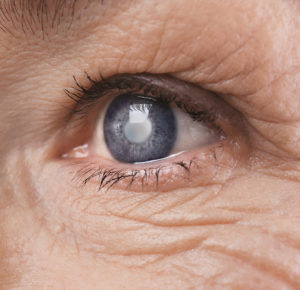Cataract Surgery
In San Diego, CA
What Are Cataracts?
Cataracts are extremely common among middle aged and older men and women, affecting around 1 in 6 people aged 40 and over, and around half of people aged 60 or older. Early cataracts may be managed through new anti-glare glasses with a different prescription and using brighter lights, but eventually you may need surgery.
What Is Cataract Surgery?
The clouding of the lens that is a cataract cannot be reversed. Once the lens in a person’s eye becomes clouded, the only way to treat the situation is through cataract surgery. Cataract surgery is a common procedure where the cataract-clouded lens is removed and replaced with an artificial lens called an intraocular lens. There are various options for patients when choosing the type of IOL they want to have placed on their eye. This surgery takes just minutes and is one of the most successful surgical procedures across the world, with success rates of 98 percent.

At American Eye Associates and California Retina Associates, we offer a wide range of cutting-edge treatments, expert surgical techniques, and the latest diagnostic services that will help you live your most healthy and comfortable life. We are happy to offer ophthalmology services to men and women in San Diego, Chula Vista, and the surrounding areas of Imperial County, California. Contact us to schedule your one-on-one consultation with one of our expert ophthalmologists today.
What is the cataract surgery like?
Frequently Asked Questions
What Can I Expect After My Cataract Surgery?
After your surgery, you’ll have an eye patch on your treated eye. We’ll also provide a protective shield to wear when sleeping for several days. At first your vision will be blurry, but it rapidly improves in just a couple days. Your eye may be somewhat itchy, but you must not rub or put any pressure on the treated eye. Heavy lifting, or anything that puts pressure on your eyes, must be avoided. You don’t want to increase blood pressure in your facial area. We’ll provide eye drops to prevent inflammation and infection and to control your eye pressure.
Full healing can take up to two months, but you can return to most daily activities in just a few days. Depending on your lens choice, you may or may not require glasses for some tasks after your surgery. If both your eyes have cataracts, we schedule the second eye for surgery one to two months after the first; they are not done at the same time.
How Long Does Cataract Surgery Take?
Cataract surgery only takes around 10 minutes. Afterwards, you’ll rest in our recovery area for about 30 minutes.
How Long After My Cataract Surgery Will My Vision Be Blurry?
Patients can become alarmed if their vision seems blurry after they remove the eye patch. This is completely normal; it takes a little time for your body’s visual system to adjust to the removal of the cataract and to adapt to the new intraocular lens put in its place. Some patients even can have wavy vision for about one hour after they remove the patch.
Most patients have some amount of blurry vision. For many this clears within several hours. For others, it can take up to a week or two to fully clear, although it begins clearing before that.
How Will I Know If I Need Cataract Surgery?
Your eye doctor will see your cataract or cataracts on your lenses long before you notice any changes in your vision. However, the mere presence of a cataract doesn’t require surgery. In many people, their cataracts aren’t blurring their vision, interfering with driving, or affecting their lives.
But cataracts usually continue to make the lens more and more cloudy. In most cases, at some point the patient will have blurred vision that feels as if he or she is looking through a dirty window. Driving at night can become a glare-filled nightmare. Seeing the cards in a bridge game can be a challenge.
At this point, it’s time to have cataract surgery with the expert team at American Eye Associates. This surgery is so successful and creates such crystal clear vision that there really isn’t any reason to delay. Plus, modern intraocular lenses can actually improve your basic vision at the same time as they are replacing your clouded natural lens.
Do Cataracts Return?
Once the clouded lens with the cataract is removed, the artificial lens that replaces the natural lens cannot develop a cataract. If you’ve only had one cataract addressed, the other eye can still develop a cataract and need surgery, but cataracts do not “return.”
